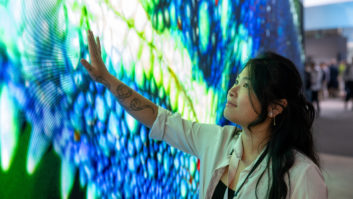
Technology is entering the workplace at the speed of light, whether it is a new AI-powered video camera you use to collaborate with colleagues around the world or the latest messaging platform helping to foster a stronger company culture. Audiovisual tech, specifically, is being used more prominently to ensure any workplace runs its daily operations smoothly, keeps employees engaged, secures an office space and beyond.
Companies are prioritising data and metrics to help with business goals ranging from employee engagement to office space allocation. Data can tell an organisation not only what happened, but why it happened, or what will happen next. This information can then be leveraged to increase ROI in valuable and strategic ways.
Aiding collaboration
Companies are developing better technology to aid collaboration and support employees in working more efficiently from a distance. Research suggests that even the perception of collaboration causes employee performance to skyrocket. As companies invest in collaboration, they also look for precise data and information on how office spaces are being utilised, how to automate workflows, how to improve the experience for all parties involved in a video call and how to plan ahead for future collaboration needs.
Simple data such as assessing how many people are present at any given time, delivered accurately, can provide information that can then be used to automate room reservations, room cancellations and beyond. Data pools are being collected to find patterns of use, which are then used to make smarter business decisions.
Beyond the workplace
The need to utilise AV technology to obtain valuable data is pervasive across industries beyond the workplace, including manufacturing, streaming media, education and advertising.
Within the education space, AV solutions can be used to connect those who are learning from a distance with students who are physically present in the classroom, then take a look at the rate of engagement to assess pivots that need to be made. Projections show the e-learning market will surpass a whopping $243 billion by 2022.
In advertising, a camera can be placed on a digital sign that can detect the amount of people walking by, along with various demographics, to help provide powerful statistics to the companies paying for the advertisements. This data can be used to impact ad placement and ROI.
What this means
The data and information delivered through advanced audio/video devices, which can also work as AI data sensors, helps companies efficiently collect information that aids them in learning how to optimise the workplace, employee experience, relationships with customers and more. This information drives organisations to assess what they need in order to grow and change, fostering faster evolution.
AV integrators can grow their business rapidly by leading the transition with solutions that combine the data sensor capabilities delivered by advanced cameras with cloud collaboration services and room reservation hardware providers, for example. This technology can automate resource management and improve participants experience by eliminating mundane tasks, such as checking into a conference room.
It is now also possible to create Big Data lakes of information and provide analysis reports that highlight patterns of use. These new opportunities require the AV integrators to think about IT use of their products, in addition to traditional AV capabilities. This shift creates opportunities for hardware manufacturers to collaborate with software service providers and managed service providers in enabling IT-powered solutions.
AI-powered sensors tie in with Internet of Things requirements for the office and beyond, including smart home and buildings in which data drives how building resources are optimised with areas such as heating and cooling, lighting, powering off television screens and more.
This is saving people time in their work life by eliminating mundane tasks. As intelligent AV becomes a more prominent technology, it will simplify how we interact with autonomous systems through natural interactions – via words, gestures and images – and work around us to fulfil our everyday needs.







